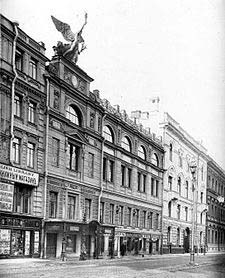Anton Mikhailovich Lavinskii 1893 - 1968
Biography
This biography has been assembled as far as is possible from many sources of sometimes conflicting information. We believe it to be as accurate as possible. Anton Lavinskii was born in Sochi, his father a maritime customs officer and his mother a cook to a wealthy family. After graduation at Sochi elementary school he moved to Baku.
In 1912 at the age of 19, and having completed his basic studies in drawing sculpture and painting at the Baku Technical School. The young Anton Lavinskii Moved to St Petersburg. Here he studied at the Imperial Society for the Encouragement of the Arts until 1915 when he joined the army and fought at the front.

In 1917, upon his demobilisation, Lavinskii returned to Sochi and worked on organising a sculpture school there. During the post revolution period 1918 to 1919 Lavinskii worked at the Petrograd Free Art Studios and studied with Aleksandr Matveyev and Leonid Shervud, he also participated in building monumental sculptures to commemorate the revolution. For a brief period during 1919 he taught at Saratov Art Studios before taking up the post of head of Sculpture at the newly formed Moscow Vkhutemas.
In Moscow, he became close to Osip Brik and in addition to his teaching activities at the Vkhutemas he actively participated in the many political and artistic meetings surrounding the activities and curriculum at the Vkhutemas and the closely related Inkhuk. His name as well as that of Alexei Babichev appears frequently alongside those of better known artists in the minutes of these meetings.

The circle of friends of Osip and Lilya Brik included Alexandr Rodchenko, Vavara Stepnova, Lyubov Popova, many of the founders of the constructivist movement, and of course Vladimir Mayakovsky, who was Lilyas lover until 1930 when he committed suicide. Lavinski was photographed by Rodchenko on several occasions. During 1922 he became disenchanted with sculpture and quit the sculpture department to work in the woodworking workshops, and later on, propaganda posters as well as theatre and film set design.
In 1925 Lavinskii travelled to Paris to assist in the decoration of the Russian pavilion of the 1925 Exhibition des Arts Industriels et Decoratifs. He may also have assisted El Lissitzky in the development of the exposition of the Soviet pavilion at the International Exhibition of Printing in Cologne. This is the last occasion he left Russia, though he undoubtedly continued to work in the field of the arts, he died in Moscow in 1968. Despite his significant contributions to the artistic efforts of the Russian revolution and the fact that his name appeared in association with every major artistic event in connection with the Vkhutemas, and the running of the Moscow Inkhuk, his name is not to be found in any major article or retrospective on the subject. The works presented here demonstrate a superior understanding of the principals of Cubist Sculpture and would sit proudly beside any major European Cubist work. The sculpture of Anton Lavinskii is every bit equal to, and arguably better than of some well known names in the history European Cubism.
If presented alongside the work of Archipenko, Lipchitz, or Laurens, the work of Anton Lavinskii would surely be praised as that of a major artist in the discipline. Here major works shown for the first time we hope will elevate his name to the level he deserves.